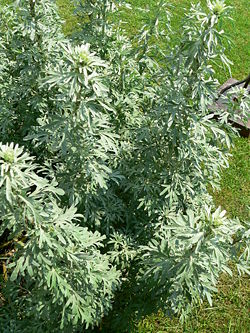Artemisia absinthium
| Artemisia absinthium | ||||||||||||||
|---|---|---|---|---|---|---|---|---|---|---|---|---|---|---|
 Artemisia absinthium growing wild in the Caucasus
|
||||||||||||||
| Scientific classification | ||||||||||||||
|
||||||||||||||
| Binomial name | ||||||||||||||
| Artemisia absinthium L.[1] |
Artemisia absinthium (absinthium, absinthe wormwood, wormwood or grand wormwood) is a species of wormwood, native to temperate regions of Europe, Asia and northern Africa.
It is a herbaceous perennial plant, with a hard, woody rhizome. The stems are straight, growing to 0.8-1.2 m (rarely 1.5 m) tall, grooved, branched, and silvery-green. The leaves are spirally arranged, greenish-grey above and white below, covered with silky silvery-white hairs, and bearing minute oil-producing glands; the basal leaves are up to 25 cm long, bipinnate to tripinnate with long petioles, with the cauline leaves (those on the stem) smaller, 5-10 cm long, less divided, and with short petioles; the uppermost leaves can be both simple and sessile (without a petiole). Its flowers are pale yellow, tubular, and clustered in spherical bent-down heads (capitula), which are in turn clustered in leafy and branched panicles. Flowering is from early summer to early autumn; pollination is anemophilous. The fruit is a small achene; seed dispersal is by gravity.
It grows naturally on uncultivated, arid ground, on rocky slopes, and at the edge of footpaths and fields.
Contents |
Cultivation and uses
The plant can easily be cultivated in dry soil. They should be planted under bright exposure in fertile, mid-weight soil. It prefers soil rich in nitrogen. It can be propagated by growth (ripened cuttings taken in March or October in temperate climates) or by seeds in nursery beds. It is naturalised in some areas away from its native range, including much of North America.
The plant's characteristic odour can make it useful for making a plant spray against pests. In the practice of companion planting, because of the secretions of its roots, it exerts an inhibiting effect on the growth of surrounding plants, thus weeds. It can be useful to repel insect larvae but it need only be planted on the edge of the area of cultivation. It has also been used to repel fleas and moths indoors.
It is an ingredient in the liquor absinthe, and also used for flavouring in some other spirits and wines, including bitters, vermouth and pelinkovac. It is also used medically as a tonic, stomachic, antiseptic, antispasmodic, carminative, cholagogue, febrifuge and anthelmintic. In the Middle Ages it was used to spice mead.[2]
Therapeutic uses
The leaves and flowering tops are gathered when the plant is in full bloom, and dried naturally or with artificial heat. Its active substances include silica, two bitter elements (absinthine and anabsinthine), thujone, tannic and resinous substances, malic acid, and succinic acid. Its use has been claimed to remedy indigestion and gastric pain, it acts as an antiseptic, and as a febrifuge. For medicinal use, the herb is used to make a tea for helping pregnant women during pain of labor. A dried encapsulated form of the plant is used as an anthelmintic. A wine can also be made by macerating the herb. It is also available in powder form and as a tincture. The oil of the plant can be used as a cardiac stimulant to improve blood circulation. Pure wormwood oil is very poisonous, but with proper dosage poses little or no danger. Wormwood is mostly a stomach medicine.[3]
Etymology and folklore
Artemisia comes from from Ancient Greek ἀρτεμισία, from Ἄρτεμις, meaning Artemis (the goddess).[1] In Hellenistic culture, Artemis was a goddess of the hunt, and protector of the forest and children.
Absinthium comes from Ancient Greek ἀψίνθιον (apsinthion) [2], possibly meaning "unenjoyable", and probably referring to the bitter nature of the derived beverage [3], though this is likely folk etymology.
The word "wormwood" comes from Middle English "wormwode" or "wermode". The form "wormwood" is influenced by the traditional use as a cure for intestinal worms. Webster's Third New International Dictionary attributes the etymology to Old English "wermōd" (compare with German Wermut and the derived drink Vermouth). An alternate explanation dubiously combines the Old English "wer", meaning "man" (as in "werewolf"), with OE "mōd", meaning "mood".
External links
- Biodiversity Heritage Library bibliography for Artemisia absinthium
- Flora of Pakistan: Artemisia absinthium
- The Virtual Absinthe Museum - A comprehensive online museum of absinthe history, lore, art and antiques.
- Erowid Wormwood Vault- information on the use and preparation of wormwood, along with user experiences.
References
- ↑ Linnaeus, Carolus (1753). Species plantarum :exhibentes plantas rite cognitas, ad genera relatas, cum differentiis specificis, nominibus trivialibus, synonymis selectis, locis natalibus, secundum systema sexuale digestas.... 2. Holmiae (Laurentii Salvii). pp. 848. http://www.biodiversitylibrary.org/page/358869. Retrieved on 2008-09-08.
- ↑ Common wormwood
- ↑ Lust, John, N.D. "The Herb Book", Bantam Books. 1979. ISBN 0879040556.